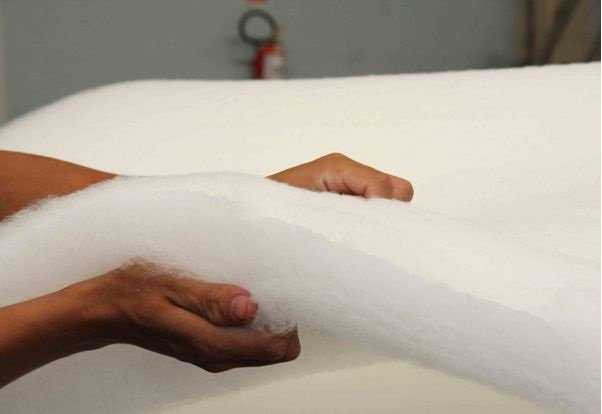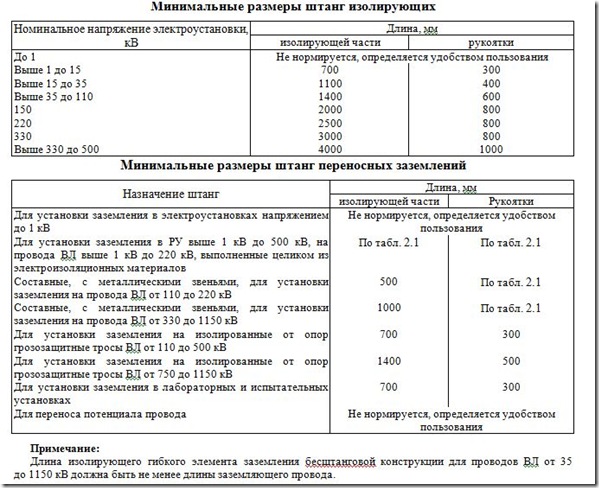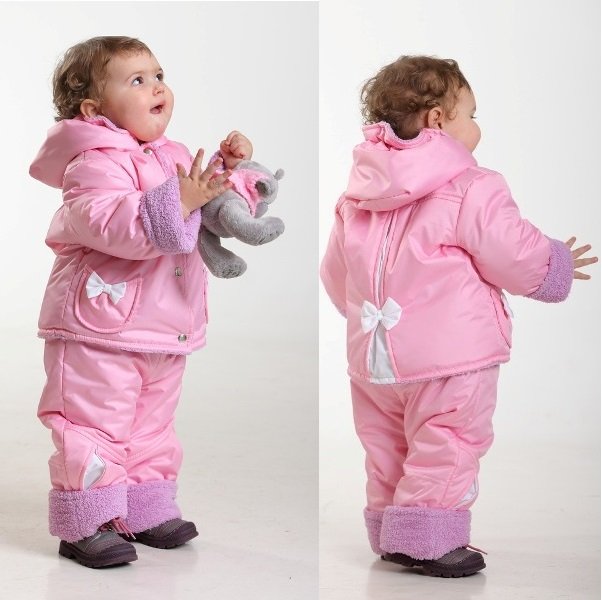Personal protective equipment
Medical protection of troop personnel from damaging factors of radiation, chemical and biological (RCB) nature is the most important component of the troop medical support system. Some of its elements are also carried out within the framework of a set of measures for such types of combat support as RCB protection and engineering support.
Medical protection- a set of measures aimed at preserving the life, health and military-professional performance of the personnel of the troops in the conditions of the impact on them of the damaging factors of the NBC nature.
The main tasks medical protection of personnel from the damaging factors of the nature of the NBC are:
prevention or mitigation of the impact on personnel of the damaging factors of weapons of mass destruction, RCB accidents and disasters;
provision of first, pre-medical and first medical aid to the affected in order to eliminate conditions that threaten the life, health and military-professional performance of the affected.
The complex of the main measures of medical protection includes: forecasting the size, structure and dynamics of the formation of the joint venture, which may arise as a result of the use of weapons of mass destruction and the destruction of environmentally hazardous objects; provision of personnel with personal medical protection equipment, training in the rules and techniques for using them; participation in the moral and psychological training of personnel for actions under the influence of the damaging factors of weapons of mass destruction and unfavorable environmental factors; the allocation of forces and means of the medical service to participate in the elimination of the consequences of the use of weapons of mass destruction by the enemy, their preparation; carrying out sanitary and anti-epidemic (prophylactic) measures aimed at preventing or reducing the impact of biological weapons on personnel.
The provision of personnel with personal medical protective equipment is carried out in accordance with the "Standards for the supply of medical equipment and property of the Armed Forces for wartime." respiratory protection, skin protection, as well as personal medical equipment. The knowledge and skillful use of personal medical equipment for each soldier is of vital importance, allowing to preserve not only combat efficiency and health, but also life itself.
Currently accepted for supply first aid kit individual(APPI) (Figure 6.1), which is designed to provide first aid to one wounded in the order of self and mutual assistance. It is a protective color case with a set of personal medical protection equipment for a serviceman.

Figure 6.1. First aid kit, individual
APPI provides antidote therapy in case of organophosphate damage; pain relief for wounds and burns; temporary stop of external bleeding, including massive with injuries to the neck, axillary region, groin, buttocks; prevention of nausea and vomiting; prevention of wound infection and bacterial lesions; prevention of radiation injuries; treatment of the circumference of the wound; the imposition of a primary aseptic and occlusive dressing; degassing of infected skin areas and adjacent areas of uniforms; disinfection of the individual water supply.
The API includes:
1. An individual anti-chemical package (IPP) is intended for partial sanitization of open skin areas (face, neck, hands) and adjacent areas of uniforms (cuffs, collar) in case of infection with OM.
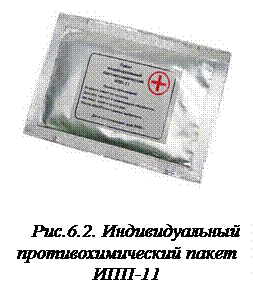 IPP-11 (Figure 6.2) is made on the basis of nonwoven materials in the form of a disposable napkin impregnated with a degassing formula and placed in a hermetically sealed film envelope. The duration of the protective action of the formulation is 6 hours. Due to the formation of a protective film, IPP-11 protects the skin from the penetration of organic substances for 30 minutes. If the agent gets on the skin (uniform), the bag is used immediately. In this case, it is necessary:
IPP-11 (Figure 6.2) is made on the basis of nonwoven materials in the form of a disposable napkin impregnated with a degassing formula and placed in a hermetically sealed film envelope. The duration of the protective action of the formulation is 6 hours. Due to the formation of a protective film, IPP-11 protects the skin from the penetration of organic substances for 30 minutes. If the agent gets on the skin (uniform), the bag is used immediately. In this case, it is necessary:
open the package;
if the gas mask is on, then wipe the open areas of the skin of the neck and hands with a napkin, as well as the face of the gas mask helmet;
if the gas mask is not worn, then, tightly closing your eyes and holding your breath, wipe the skin of your face and neck with a napkin. Without opening your eyes, wipe the skin around the eyes, and put on a gas mask;
after processing the skin of the face and putting on a gas mask, wipe the hands, the edges of the collar and cuffs of the uniform adjacent to the open areas of the skin with a napkin;
wet the infected areas of the uniform with the liquid of the bag.
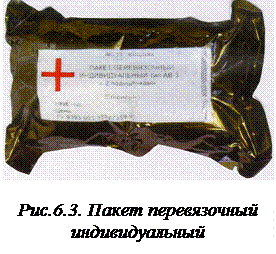 2. Individual dressing package (PPI) (Fig.6.3) consists of two cotton-gauze pads attached to the bandage. One of the pads is motionless, the other can be moved. The pads and the bandage are in two casings: the inner one is made of paper, the outer one is made of rubberized fabric. The envelopes of the package reliably protect it from the ingress of microbes and radioactive substances.
2. Individual dressing package (PPI) (Fig.6.3) consists of two cotton-gauze pads attached to the bandage. One of the pads is motionless, the other can be moved. The pads and the bandage are in two casings: the inner one is made of paper, the outer one is made of rubberized fabric. The envelopes of the package reliably protect it from the ingress of microbes and radioactive substances.
To use the package you need:
tear the shell along the incision and remove it;
remove the pin from the fold of the paper shell, unfold the shell and discard;
with your left hand, take the end of the bandage, expanding it to the roll;
take the roll with your right hand and unfold the package;
in case of a through wound, move the movable pad with the right hand and close each of the wound holes with one pad, and then strengthen them with a bandage;
in case of a blind wound or burn with the left hand, move the movable pad to the fixed one. Small wounds are closed with one pad, and the second is placed on top. With an extensive wound, the pads are placed side by side;
put pads on the wound, without touching foreign objects, and attach the end of the bandage with a pin;
colored thread shows the outer side of the pad (which you can touch with your hand).
3. Antiemetic drug - the drug ondansetron 0.04 in tablets, one package (10 pcs.), Used to stop the body's primary reaction to radiation sickness, take 1 ... 2 tablets at the threat of radiation or after it when nausea appears. Also used when nausea occurs after concussions and head injuries. Repeated admission is possible during the day.
4. Radioprotective agent - drug B-190 0.15 in tablets, one package (10 pcs.), Used in case of a threat of radiation at a dose of more than 1 Gy (100 rad). For 10 ... 15 minutes before the start of radiation exposure, it is necessary to take 3 tablets of the drug B-190. Re-use of the B-190 preparation is possible 1 hour after the first use, and during the day, the B-190 preparation can be used up to 3 times.
5. Antiseptic agent - iodine 5% alcohol solution, contained in a 1 ml ampoule in a braid, used to treat the circumference of the wound.
6. Antibacterial agent - the drug doxycycline 0.1 active substance in a capsule, one package (10 pcs.), Is used when there is a threat of damage by biological agents, as well as for injuries and burns (for the prevention of wound infection) 2 capsules at the same time, after 12 hours 2 more capsules.
7. Antidote against OPF - Pelixim, 1 ml injection solution, contained in a syringe tube with a red cap. It is administered subcutaneously or intramuscularly at the first signs of FOV lesion: pupil constriction, difficulty in exhaling (bronchospasm), muscle cramps, excessive salivation and sweating. In case of insufficient effectiveness of the treatment, it is allowed to re-administer the drug after 1 hour (Figure 6.4).

Figure 6.4. Syringe tube with red cap
(pelixim, solution for injection, 1 ml)
8. Analgesic agent, contained in a syringe tube with an unpainted cap. A 0.03% buprenorphine solution is used as an analgesic agent. This remedy is used for extensive burns, fractures of large bones as a measure to prevent shock - a life-threatening complication of severe damage to the body. Do not use for penetrating wounds to the head, accompanied by respiratory failure, since the drug inhibits the work of the respiratory center located in the medulla oblongata (Figure 6.5).
Figure 6.5. Syringe tube with unpainted cap
(buprenorphine, solution for injection, 1 ml)
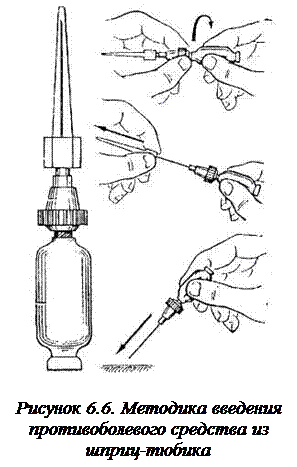 When using a syringe tube, it is necessary (Figure 6.6):
When using a syringe tube, it is necessary (Figure 6.6):
take the syringe-tube in the right hand with the thumb and forefinger by the body, with the left hand rotate the cannula around the axis (screw) until it stops and, thereby, pierce the membrane;
remove the cap without touching the needle, grab the ribbed part of the cannula;
without unclenching your fingers, insert the needle to a depth of 3 cm into the external muscle of the thigh to yourself or to a friend;
grasping the body of the syringe tube with your thumb and forefinger, squeeze the liquid out of the tube. Do not open your fingers until the needle is removed to prevent the medicine from sucking back into the tube body. In severe cases of injury, the needle can be inserted into the muscle without removing clothing. Do not throw away the empty syringe tube!
9. Hemostatic dressing "Hemostop" sterile (based on zeolite derivatives), 50 g per package. It is used to stop bleeding by applying an individual dressing package to the damaged vessel using a pressure method.
- Rules for the use of electrical protective equipment when carrying out work in electrical installations
- How to sew fleece mittens
- Protective equipment in electrical installations
- Computer glasses: which is better to choose
- How to wash clothes with Thinsulate insulation
- Training in electrical safety, labor protection, ecology, electrical safety, fire-technical minimum, first aid to victims of the courses
- Protective equipment in electrical installations up to and above 1000 Volts
- What is fleece fabric, where is it used and how to care for it
- Personal protective equipment
- What is this fabric?
- Thinsulate
- "From the" Royal Circus "by Gia Eradze
- Drugs, longing for a friend, or murder
- Taisiya Povaliy (Giryavets) - biography, personal life and discography of the Ukrainian singer
- Viktoria karaseva's relatives are worried about the fact that she stopped leaving Tori's house from house 2 now
- Brief biography of Glinka What oppressed Glinka
- Biography and personal life of Maria Sittel Life of Maria Sittel
- T-Killah: nobody ever left me Alexander Tarasov got married
- Unknown facts about famous writers
- Maxim Gorky: biography, personal life M bitter direction




